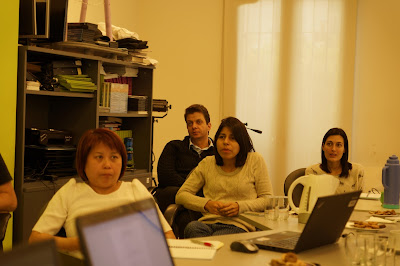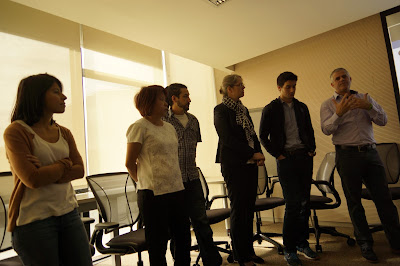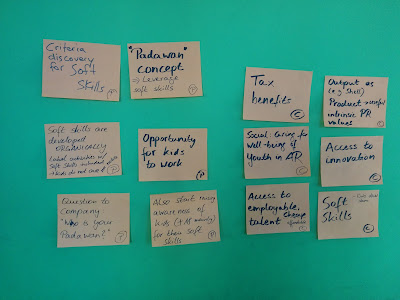On May 1, Lufthansa flight 511 from Buenos Aires to Frankfurt landed on time, my husband picked me up at the airport, and an hour later, I was home. Well, physically. It seems that the soul travels a lot slower. It took me a couple of days before I really felt being home. The impressions and experiences during this Social Sabbatical were just too intense...
Before writing this article on my reflections about these four weeks in Buenos Aires, let me first share the link to our Puerta 18 video that we showed during the final presentation:
Documentary of SAP Social Sabbatical team at Puerta 18
(Written, directed, ... by: Juan Manuel Cafferata - thank you, Juami, for this great video!)
Let me share some stray observations and impressions from the time in Buenos Aires after having a week to reflect on the whole experience:
When preparing for the Social Sabbatical, we tried to anticipate what to expect. But to be honest, the reality was then quite different. It is possible to read about an organization like Puerta 18 on their homepage and Facebook page - but to really feel the work with the kids every day is just a completely different experience!
Which brings me to one key finding about this Social Sabbatical: One central skill you have to bring for such an experience is to being able to listen and perceive! Actually, this should not be anything that blows your mind - this is true for many situations at work, as long as your work requires you to come up with ideas around a given domain.
Creation of ideas: This is something we did a lot during the Social Sabbatical. This covers the collection of information and first drafts of ideas on the one hand. Make sure to have all the necessary input, then start clustering and prioritizing. For this step, the stakeholder input is essential. From there, start discussing, and ideas will start to develop... Loosely, this adapted the essence of design thinking, even without strictly applying all terms and steps of this process.
For us, this methodology - as we applied it - provided several benefits. First, by representing our input on paper. This offered us a method to check whether we were looking at all relevant details - and we could check that the most important aspects were present together with the Puerta 18 team. Second, from defining priorities together, we got an idea on where to start. And third, by starting to discuss the connections between various aspects, we somehow automatically started to come up with ideas on how to approach possible solutions.
Which also means: Teamwork is an essential aspect! Take Rob and myself as an example: Rob is from Marketing, I am working in Development Architecture. I suppose there are few combinations of SAP colleagues whose areas are further apart than ours... - but this combination was just perfect to contribute more diverse points of views and offer different approaches to solutions. Janice brought in a third aspect, that is her experience from her work at financials.
When talking to different people, you often face the problem that they have different expectations and provide you with contradicting input. This problem is very familiar to developers... But here, we didn't face it at all. Quite the contrary: One thing we experienced was the consistency in the information we received. This helped a lot and showed us how serious the goal to work with the kids' ideas is.
Finally, we needed to be very flexible. On the one hand, there were so many things to do, people to talk to, and the team needed to be aligned at all times. We changed a lot between team time and distributed work - someone who needs a structured daily routine probably would feel uncomfortable... On the other hand, let's be honest: Argentina is not a country where people are famous for being on time. Times of appointments are rather guidelines than rules, and schedules of meeting partners are frequently subject to change. It is impossible to fix a long-term plan and insist on pulling this through - be very open to adapt even several times per day. An opportunity to talk to someone might come in, and thus all subsequent plans will easily be invalidated. We just immersed into this rhythm and had the feeling that we had the chance to speak to all persons we wanted to address, and thus could collect input from many different angles.
Let me close this last posting of my blog with a reflection on the country itself. I was in Buenos Aires in 2001 and 2003 - just around the heavy economic crisis of 2001/2 (see this article on Wikipedia for further reading). Take a look at Koert Breebaart's blog about the economy in the country - you find the link in the column on the right! Since my last visits to the country, the economic situation was a continuous challenge for the country - and this could be seen at many places. See my article on money which is a symptom going back to these roots... Also the sidewalks on the streets with many holes and deteriorating buildings tell the tale of better times.
All in all, the choice of Argentina as a country to host a Social Sabbatical team was a good one. I hope that our client Puerta 18, as well as the other three NGOs working together with the other subteams, will be able to profit from our work, and I am looking forward to following their progress!
With these reflections, I am closing this blog. Many thanks to everyone who contributed to making this experience unique and unforgettable, as well as to all readers of this blog!
Before writing this article on my reflections about these four weeks in Buenos Aires, let me first share the link to our Puerta 18 video that we showed during the final presentation:
Documentary of SAP Social Sabbatical team at Puerta 18
(Written, directed, ... by: Juan Manuel Cafferata - thank you, Juami, for this great video!)
Let me share some stray observations and impressions from the time in Buenos Aires after having a week to reflect on the whole experience:
When preparing for the Social Sabbatical, we tried to anticipate what to expect. But to be honest, the reality was then quite different. It is possible to read about an organization like Puerta 18 on their homepage and Facebook page - but to really feel the work with the kids every day is just a completely different experience!
Which brings me to one key finding about this Social Sabbatical: One central skill you have to bring for such an experience is to being able to listen and perceive! Actually, this should not be anything that blows your mind - this is true for many situations at work, as long as your work requires you to come up with ideas around a given domain.
Creation of ideas: This is something we did a lot during the Social Sabbatical. This covers the collection of information and first drafts of ideas on the one hand. Make sure to have all the necessary input, then start clustering and prioritizing. For this step, the stakeholder input is essential. From there, start discussing, and ideas will start to develop... Loosely, this adapted the essence of design thinking, even without strictly applying all terms and steps of this process.
For us, this methodology - as we applied it - provided several benefits. First, by representing our input on paper. This offered us a method to check whether we were looking at all relevant details - and we could check that the most important aspects were present together with the Puerta 18 team. Second, from defining priorities together, we got an idea on where to start. And third, by starting to discuss the connections between various aspects, we somehow automatically started to come up with ideas on how to approach possible solutions.
Which also means: Teamwork is an essential aspect! Take Rob and myself as an example: Rob is from Marketing, I am working in Development Architecture. I suppose there are few combinations of SAP colleagues whose areas are further apart than ours... - but this combination was just perfect to contribute more diverse points of views and offer different approaches to solutions. Janice brought in a third aspect, that is her experience from her work at financials.
When talking to different people, you often face the problem that they have different expectations and provide you with contradicting input. This problem is very familiar to developers... But here, we didn't face it at all. Quite the contrary: One thing we experienced was the consistency in the information we received. This helped a lot and showed us how serious the goal to work with the kids' ideas is.
Finally, we needed to be very flexible. On the one hand, there were so many things to do, people to talk to, and the team needed to be aligned at all times. We changed a lot between team time and distributed work - someone who needs a structured daily routine probably would feel uncomfortable... On the other hand, let's be honest: Argentina is not a country where people are famous for being on time. Times of appointments are rather guidelines than rules, and schedules of meeting partners are frequently subject to change. It is impossible to fix a long-term plan and insist on pulling this through - be very open to adapt even several times per day. An opportunity to talk to someone might come in, and thus all subsequent plans will easily be invalidated. We just immersed into this rhythm and had the feeling that we had the chance to speak to all persons we wanted to address, and thus could collect input from many different angles.
Let me close this last posting of my blog with a reflection on the country itself. I was in Buenos Aires in 2001 and 2003 - just around the heavy economic crisis of 2001/2 (see this article on Wikipedia for further reading). Take a look at Koert Breebaart's blog about the economy in the country - you find the link in the column on the right! Since my last visits to the country, the economic situation was a continuous challenge for the country - and this could be seen at many places. See my article on money which is a symptom going back to these roots... Also the sidewalks on the streets with many holes and deteriorating buildings tell the tale of better times.
All in all, the choice of Argentina as a country to host a Social Sabbatical team was a good one. I hope that our client Puerta 18, as well as the other three NGOs working together with the other subteams, will be able to profit from our work, and I am looking forward to following their progress!
With these reflections, I am closing this blog. Many thanks to everyone who contributed to making this experience unique and unforgettable, as well as to all readers of this blog!


































